The NVIDIA SHIELD Android TV Review: A Premium 4K Set Top Box
by Ganesh T S on May 28, 2015 3:00 PM EST- Posted in
- Media Streamer
- Home Theater
- TV
- 4K
- Shield
- NVIDIA
System Performance
From an editorial perspective, the SHIELD Android TV may be one of the most frustrating devices we’ve worked on in recent history. Simply put, the Android TV market is still a tiny market. Google’s Nexus Player is most of the market right now, and only very recently have other Android TV devices such as the Forge TV and SHIELD Android TV reached the market.
As a result, figuring out what to compare the SHIELD Android TV to and how to present it has been an interesting challenge. A set top box is not a mobile device, and while they share similar OSes and the same families of SoCs, that does not make them identical devices. At the same time however, if we restrict ourselves to just Android TV devices, it would be a very limited and uninteresting comparison. The Nexus Player is a quad-core Intel Atom, but only includes 1GB of RAM, among other limitations.
Ultimately it’s clear that the SHIELD Android TV is heavily overspeced compared to other Android TV devices – no one else is pursuing this premium market – so instead we’re going to focus on looking at benchmarked performance relative to the newest generation of SoCs in the latest iOS and Android tablets. This is by no means a fair matchup and we need to be clear about this – the SHIELD Android TV has no throttling or power constraints, no need to balance out energy efficiency – but it at least gives us some idea of how the device and Tegra X1 compare to other products. Just don’t expect to see a Tegra X1 tablet perform this well. And in the meantime, some of the results may surprise you.
As always for an Android device review, we'll start off with our browser benchmarks. SHIELD Android TV doesn’t actually ship with a browser – we had to sideload Chrome – but these are among our most flexible benchmarks and help put performance in context of more than just Android devices.
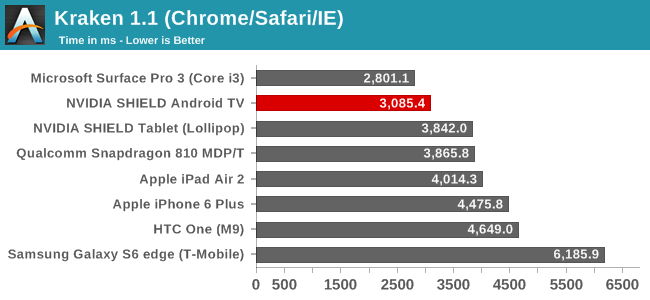
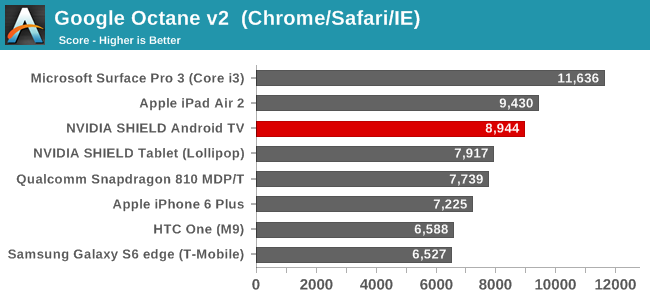
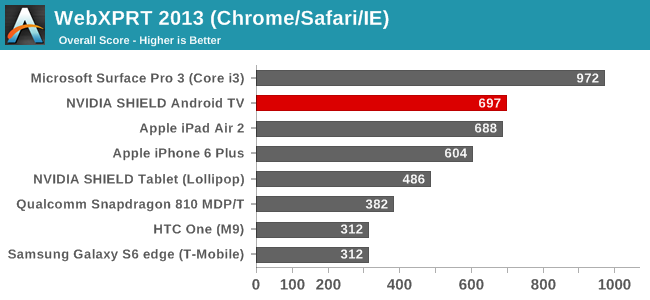
Among Android devices, the SHIELD Android TV stands alone, as you’d expect. Without any throttling to hold it back, it leads over Tegra K1, Snapdragon S810, and Exynos 7420 over all 3 web benchmarks. That said, even with its unrestricted Cortex-A57 CPU cores, we also find that Apple’s A8X-based iPad Air 2 is a close match in Octane and WebXPRT, just edging out the SHIELD Android TV and being edged out respectively. Meanwhile for anyone curious how this compares to high-end x86 tablets like the Surface Pro 3, well even SHIELD Android TV isn’t quite up to par with those devices at this time.
Moving on, we have Basemark OS II 2.0, which should give a better picture of CPU performance in addition to overall device performance.
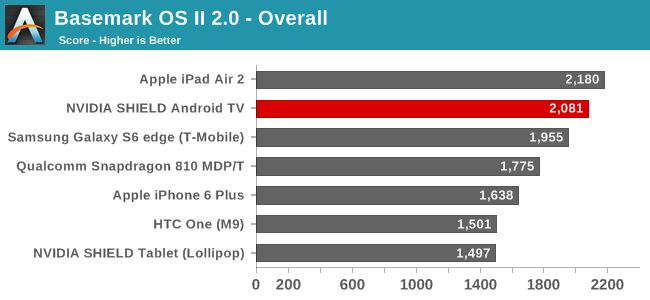

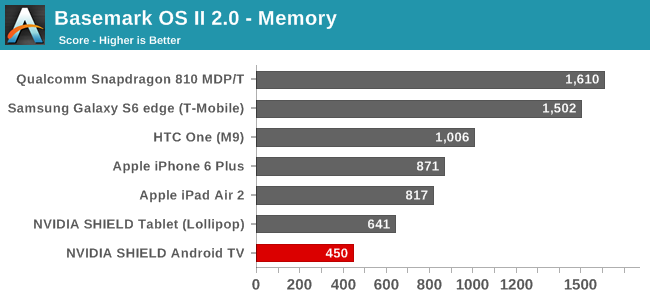
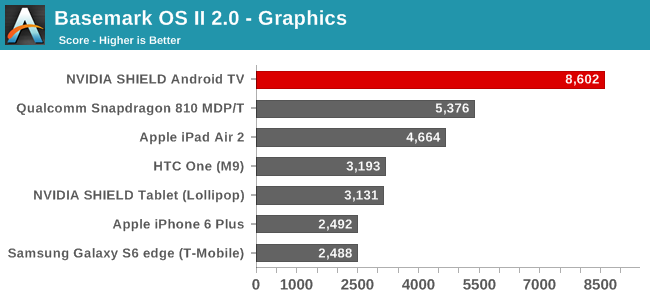
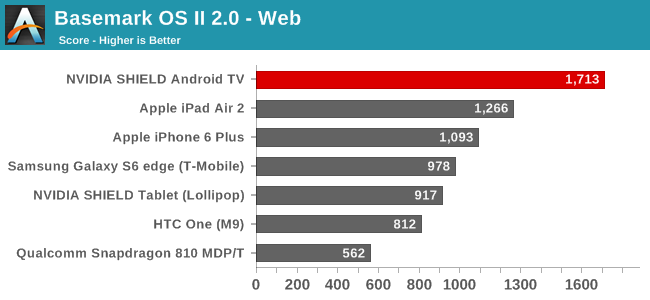
Overall, performance under Basemark still slightly favors the iPad Air 2. SHIELD Android TV easily takes the second spot, but it’s not enough to catch Apple’s tablet.
Looking at the subscores, we can see why this is. SHIELD Android TV only fares decently under the System test, but not well. The big surprise here is not the iPad, which always does well, but the fact that the SHIELD is so far behind the Galaxy S6, which features a similar CPU setup. As this sub-test pushes both the CPU and memory, we may be seeing something related to the implementation differences between Tegra X1 and Exynos 7420, or it may just be an Android TV-inspired difference.
However the memory score is particularly bad, coming in behind even the last-generation SHIELD Tablet. As this is a NAND test, what we're likely seeing is a consequence of the SHIELD's poor random performance, something we'll dive into a bit later in our detailed look at NAND performance.
On the other hand, graphics and web performance are outstanding. We had certainly expected the SHIELD to do well in graphics given what Maxwell is capable of – it is a graphics monster unlike any other current SoC – but the web test is a pleasant surprise. The combination of using Android TV’s built-in web view and the lack of any real throttling likely play a big part here, and although Android TV doesn’t ship with a standard web browser, this bodes well for any apps making use of web view and Javascript.
Our next system benchmark is PCMark, which does a number of basic benchmarks designed to stress various aspects of the device in everyday workloads like video playback, web browsing, text editing, and photo editing. This tends to test every aspect of a mobile device, unlike microbenchmarks that can often miss aspects of the system that can affect performance.
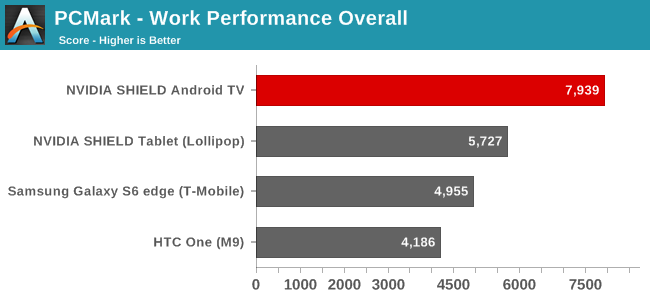
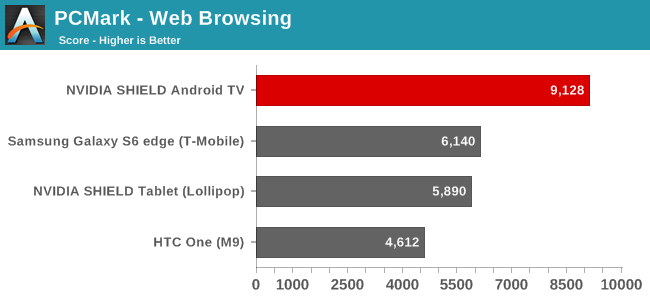

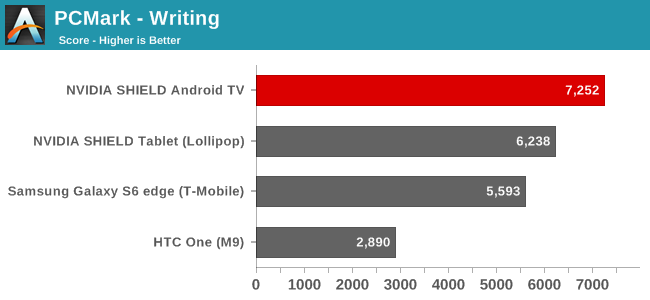
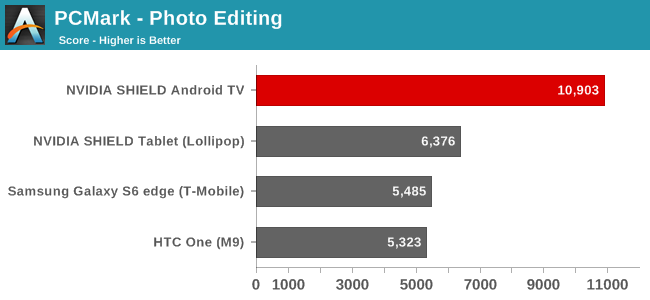
With the exception of the Writing subtest, where the SHIELD Android TV and second-place device are kind of close, PCMark is a runaway victory for the SHIELD Android TV. Once again we’re almost certainly seeing the benefits of the box’s aggressive performance since it doesn’t need to throttle down, or even be conservative on clockspeeds for power purposes. In which case it gives us an interesting look at what Cortex-A57 can do when not held back.
Overall, CPU/system performance is more or less what one would expect based on the design of the SHIELD. As a set top box with a quad-core A57 implementation under the hood and the cooling to let it run wild, SHEILD is frequently A57 at its best. Which means it’s going to easily surpass other A57 devices in most situations, but it also means that even with its unrestricted performance, Apple’s A8X processor and its tri-core “Enhanced Cyclone” CPUs still serve as a reminder of those times where A57 struggles against Enhanced Cyclone’s high-IPC design.
For our final look at system performance, let’s take a quick look at the SHIELD's built-in NAND performance with AndroBench 4.0.
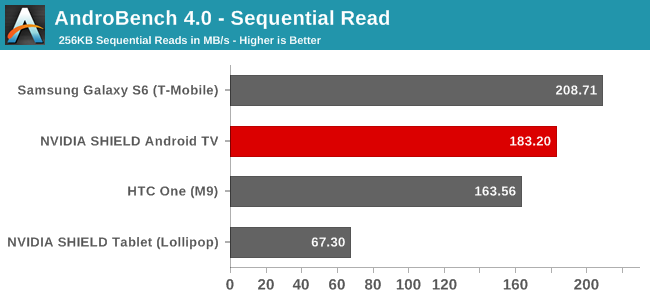
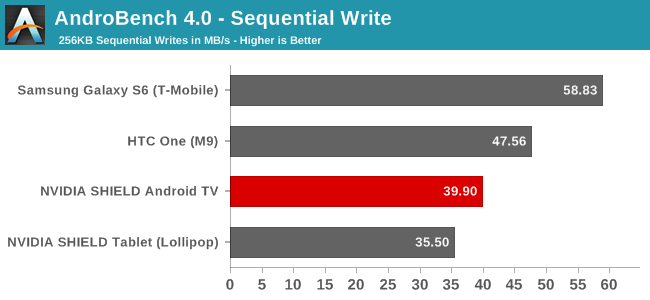
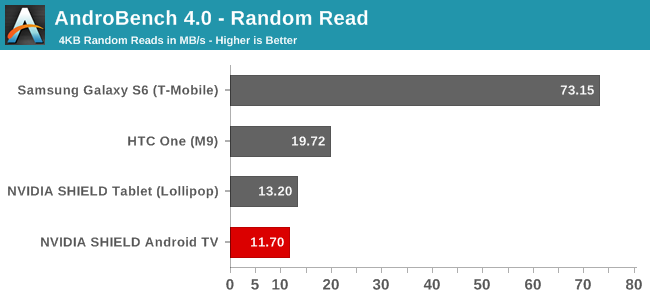
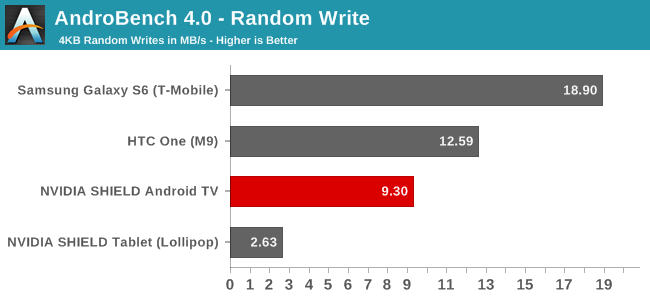
Update 5/28: AndroBench numbers have been revised to account for an error, sorry about that
Though we only have a few AndroBench 4.0 results compiled so far, it’s enough to paint a decent picture. For sequential reads the SHIELD’s built-in NAND fares relatively well. It’s not enough to top the Galaxy S6 and its UFS flash, but it’s keeping up with the pack. Sequential writes on the other hand aren't quite as good, with write performance ahead of only the SHIELD Tablet. Meanwhile random performance is a real mixed bag; the SHIELD Android TV is at the bottom of the random read chart - below even the SHIELD Tablet - while random write performnace is significantly better than the tablet, but still chasing the M9 and well off the S6.
Among Android flagship devices UFS definitely gives the Galaxy a big benefit here, but the SHIELD could stand to improve all the same. However I’m not sure how much that matters to NVIDIA, as the SHIELD is clearly designed to lean on external storage via microSD/USB for users who end up using it for storage-intensive needs such as gaming as opposed to basic set top box streaming.










167 Comments
View All Comments
ES_Revenge - Wednesday, June 10, 2015 - link
Perhaps not but Tegra X1 might be Maxwell but it's only 256:16:16 with 512 GFLOP SP performance. That in the realm of a GT 730...and the GDDR3 730 is faster than that, lol. In AMD-speak that's around equal to an R7 240.PS4 OTOH is a little below an R9 270 (around a GTX 660) and has over 1800 GFLOP SP performance. "On paper" it's already about 4x faster computationally, and it has about 7x the VRAM bandwidth.
Trying to compare a 7850/R9 270/GTX 660 to an R7 240/GT 730 is lulz though and it's very hard to find any kind of direct comparison between the two because they're never tested together and low end cards are typically tested at lower res and settings than higher end ones. It may not be actually an order of magnitude difference quantitatively but that's not really here nor there in the real world. In 1080p, we're talking about the difference between 10-15 FPS (i.e. totally unplayable) to 30-50 FPS (not spectacular but still very playable), between the two. The qualitative difference between 10FPS and 30FPS is HUGE so it seems like "an order of magnitude" in realith.
Nevermind the CPU side is well behind the 4M/8T Jaguar x86 CPU in the PS4.
MJJackson - Saturday, June 29, 2019 - link
Isso que eu chamo de bíblia hein. Como você teve disposição para escrever tudo isso? E como este site suporta tantos caracteres em um comentário?MJJackson - Saturday, June 29, 2019 - link
Isso que eu chamo de bíblia hein. Como você teve disposição para escrever tudo isso? E como este site suporta tantos caracteres em um comentário?Samus - Friday, May 29, 2015 - link
So this is a $200-$300 Roku on steroids?Udo - Tuesday, June 2, 2015 - link
No, on gamma radiation.ToTTenTranz - Friday, May 29, 2015 - link
And it'll do jack for selling Tegra devices because:1 - Such games have been in the PC for years or even a decade. Whoever wants to play them, can do it on a PC.
2 - Being greedy and making these games exclusive to Tegra devices/consoles means they won't ever enlarge the market for higher-end games on Android, which in turn won't ever raise the demand for higher-performing Android devices (like Tegra X1).
mkozakewich - Saturday, May 30, 2015 - link
People are replacing their computers with tablets and things, so I could imagine someone junking their six-year-old computer and getting this, and just getting a large phone for any mobility needs.I personally don't have any of the latest consoles or a new TV; so if I was going to get one right now, I'd try to get a 4K TV and this console would be really tempting.
smorebuds - Thursday, May 28, 2015 - link
Nintendo should come out with an Android-based console. And start making mobile games that can scale up to tv size. And let us play touch optimized pokemon on our phones dammit.testbug00 - Thursday, May 28, 2015 - link
Why android? They have ARM consoles, they know to do touch. Going android just makes it easier for other android users to get Nintendo games pirated...tipoo - Thursday, May 28, 2015 - link
Their own operating systems all being slow as molasses could be a reason, though that could also be down to the hardware.